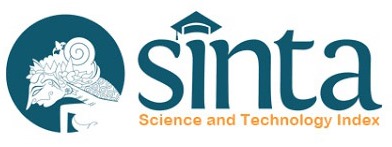Karakteristik Nori Campuran Rumput Laut Ulva sp. dan Gracilaria sp. yang Diproses dengan Metode Casting
Abstract
Produk nori saat ini cukup diminati konsumen, namun rumput laut Phorphyra sebagai bahan baku nori merupakan jenis rumput laut yang ketersediaannya terbatas. Untuk itu diperlukan teknologi pengolahan nori yang bahan bakunya ada di Indonesia, antara lain Ulva sp. dan Gracilaria sp. Penelitian ini bertujuan untuk mengetahui karakteristik fisik dan kimia nori yang dibuat dari campuran rumput laut Ulva sp. dan Gracilaria sp. Pada penelitian ini dilakukan pembuatan nori menggunakan rumput laut Ulva sp. dan Gracilaria sp. dengan rasio sebesar 100:0; 75:25; 50:50; 25:75; 0:100 (b/b) melalui metode casting. Parameter yang diamati yaitu karakteristik fisik (ketebalan, kekerasan, dan warna) dan karakteristik kimia (kadar air, abu, lemak, protein, serat pangan, dan total karbohidrat). Hasil penelitian menunjukkan bahwa karakteristik nori yang dihasilkan berbeda nyata antar perlakuan. Perlakuan terbaik pada penelitian ini yaitu nori dengan rasio Ulva sp. dan Gracilaria sp. 100:0 b/b, walaupun kualitasnya masih di bawah nori komersial. Nori tersebut memiliki ketebalan 0,62 mm, parameter warna (L 31,59; a* -1,11; b* 15,51), kekerasan 595,06 g, kadar air 8,63%, abu 23,47%, lemak 10,64%, protein 9,34%, total karbohidrat 47,91%, dan serat pangan 28,20%.
Abstract
Nori Product become more popular recently, however, the availability of Porphyra as raw material for nori is very limited in Indonesia. For this reason, nori processing technology using seaweeds other than Porphyra such as Ulva sp. and Gracilaria sp. is required. The objective of this experiment is to evaluate the physico-chemical characteristics of nori which was processed from Ulva sp. and Gracilaria sp. seaweeds. In this experiment, the proportions of Ulva sp. and Gracilaria sp. for nori processing were 100:0; 75:25; 50:50; 25:75; 0:100 (w/w) using casting method. The parameters used to evaluate the physical characteristics were thickness, colour, and hardness, while the chemical parameters were moisture, ash, fat, protein, dietary fiber, and total carbohydrate. The results showed that the characteristics of the processed nori were different significantly between samples. The best treatment was gained from ratio of Ulva sp. and Gracilaria sp. in a proportion of 100:0 w/w. The quality of the product, however, was still lower than commercial nori, with the characteristics as follows: thickness 0.62 mm, colour (L 31.59; a* -1.11, b* 15.51), hardness 595.06 g, moisture content 8.63%, ash 23.47%, fat 10.64%, protein 9.34%, total carbohydrate 47.91%, and dietary fibre 28.20%
Keywords
Full Text:
PDF (Bahasa Indonesia)References
Aulia, A., Munandar, A., & Surilayani, D. (2021). Optimalisasi formulasi nori rumput laut Kappaphycus alvarezii dengan daun singkong (Manihot utilisima). Media Teknologi Hasil Perikanan, 9(2), 51–58.
Badan Standardisasi Nasional (BSN). (2010a). SNI 2354.1-2010 Cara uji kimia - Bagian 1: Penentuan kadar abu dan abu tak larut asam pada produk perikanan. Badan Standardisasi Nasional.
Badan Standardisasi Nasional (BSN). (2010b). SNI 2354.3-2010 Cara uji kimia - Bagian 3: Penentuan kadar lemak total pada produk perikanan. Badan Standardisasi Nasional.
Badan Standardisasi Nasional (BSN). (2010c). SNI 2354.4-2010 Cara uji kimia - Bagian 4: Penentuan kadar protein dengan metode total nitrogen pada produk perikanan. Badan Standardisasi Nasional.
Badan Standardisasi Nasional (BSN). (2015). SNI 2354.2-2015 Cara uji kimia- Bagian 2: Penentuan kadar air pada produk perikanan. Badan Standardisasi Nasional.
Chen, K., & Roca, M. (2018). Cooking effects on chlorophyll profile of the main edible seaweeds. Food Chemistry, 266(June), 368–374. https://doi.org/10.1016/j.foodchem.2018.06.040
Cian, R. E., Caballero, M. S., Sabbag, N., González, R. J., & Drago, S. R. (2014). Bio-accessibility of bioactive compounds (ACE inhibitors and antioxidants) from extruded maize products added with a red seaweed Porphyra columbina. LWT - Food Science and Technology, 55(1), 51–58. https://doi.org/10.1016/j.lwt.2013.08.011
Darmawan, M., Santoso, J., Fransiska, D., & Marsella, M. (2020). The Effect of alkali and acid pretreatment to the quality of bacto agar from Gelidium sp. Jurnal Pascapanen Dan Bioteknologi Kelautan Dan Perikanan, 15(1), 33. https://doi.org/10.15578/jpbkp.v15i1.645
Dewi, E. N. (2018). Ulva lactuca. In Buku. Fakultas Perikanan dan Ilmu Kelautan Unoversitas Diponegoro.
Ditjen PDSPKP. (2020). Potensi pengembangan nori di Indonesia (dalam FGD Tema pengembangan nori berbahan baku lokal).
Freile-Pelegrín, Y., Madera-Santana, T., Robledo, D., Veleva, L., Quintana, P., & Azamar, J. A. (2007). Degradation of agar films in a humid tropical climate: Thermal, mechanical, morphological and structural changes. Polymer Degradation and Stability, 92(2), 244–252. https://doi.org/10.1016/j.polymdegradstab.2006.11.005
Herawati, H. (2018). Potensi hidrokoloid sebagai bahan tambahan pada produk pangan dan nonpangan bermutu. Jurnal Penelitian Dan Pengembangan Pertanian, 37(1), 17. https://doi.org/10.21082/jp3.v37n1.2018.p17-25
Hidayati, J. R., Yudiati, E., Pringgenies, D., Oktaviyanti, D. T., & Kusuma, A. P. (2020). Comparative Study on antioxidant activities, total phenolic compound and pigment contents of tropical spirulina platensis, Gracilaria arcuata and Ulva lactuca extracted in different solvents polarity. E3S Web of Conferences, 147. https://doi.org/10.1051/e3sconf/202014703012
Hui, Y. H. (2006). Handbook of Food Science, Technology, and Engineering (Vol. 1). CRC Press.
Irwan, Z. (2020). The Nutritional content of moringa leaves based on drying methods. Jurnal Kesehatan Manarang, 6(1), 69. https://doi.org/10.33490/jkm.v6i1.231
Kurniawan, K., & Bintoro, N. (2019). Engineering analysis in manufacturing process of nori made from mixture of Ulva lactuca and Gracillaria sp. IOP Conference Series: Earth and Environmental Science, 355(1). https://doi.org/10.1088/1755-1315/355/1/012036
Lalopua, V. M. (2018). Karakteristik nori rumput laut merah Hypnea saidana menggunakan metode pembuatan berbeda dengan penjemuran matahari. Majalah BIAM, 14(1), 28. https://doi.org/10.29360/mb.v14i1.3890
Lalopua, V. M. N. (2017). Karakteristik nori tiruan menggunakan bahan baku alga Hypnea saidana dan Ulva conglubata dari perairan Maluku. Majalah BIAM, 13(2), 33. https://doi.org/10.29360/mb.v13i2.3529
Loupatty, V. D. (2002). Nori nutrient analysis from seawed of Porphyra marcossi in Maluku Ocean Voulda D. Loupatty Balai Riset dan Standarisasi Industri Ambon Jl. Kebun Cengkih, Ambon. Eksakta, 14(2), 34–48.
Ma’ruf, W. F., Ibrahim, R., Dewi, E. N., Susanto, E., & Amalia, U. (2013). Caulerpa racemosa dan Gracilaria verrucosa sebagai edible food. Jurnal Saintek Perikanan, 9(1), 68–74.
Ministry of Education, Culture, sports, S. and T (MEXT). (2015). Standard tables of food composition in Japan Seventh revised edition. Tokyo (JPN).
Noda, H. (1993). Health benefits and nutritional properties of nori. Journal of Applied Phycology, 5(2), 255–258. https://doi.org/10.1007/BF00004027
Norziah, M. H., & Ching, C. Y. (2000). Nutritional composition of edible seaweed Gracilaria changgi. Food Chemistry, 68(1), 69–76. https://doi.org/10.1016/S0308-8146(99)00161-2
Nurhajar. (2021). Pemanfaatan rumput laut (Gracilaria sp.) untuk meningkatkan pertumbuhsn dan sintasan ikan bandeng (Chanos chanos). Skripsi. Program Budidaya Perairan, Fakultas Pertanian, Universitas Muhammadiyah Makassar.
Paramita, O., & Mulwinda, A. (2012). Pembuatan database fisiokimia tepung umbi - umbian di Indonesia sebagai rujukan diversifikasi pangan. Jurnal Sains Dan Teknologi, 10(1), 64–75.
Polat, S., & Ozogul, Y. (2013). Seasonal proximate and fatty acid variations of some seaweeds from the northeastern Mediterranean coast. Oceanologia, 55(2), 375–391. https://doi.org/10.5697/oc.55-2.375
Prabowo, I., Sulistiono, S., & Mumtaminah, D. (2020). Karakterisitik edible film yang diproduksi dari kombinasi Ulva Lactuca dan gelatin. Jurnal Ilmu Perikanan Dan Kelautan, 2(2), 81–92.
Putra, D. A. P., Agustini, T. W., & Wijayanti, I. (2015). Pengaruh penambahan karagenan sebagai stabilizer terhadap karakteristik otak-otak ikan kurisi (Nemipterus Nematophorus). Jurnal Pengolahan Dan Bioteknologi Hasil Perikanan, 4(2), 1–10.
Putri, R. C. T., & Ningtyas, S. A. (2017). Pembuatan nori dari rumput laut campuran jenis Ulva lactuca linnaeus dan Glacilaria sp. Program Studi Diploma III Teknik Kimia, Fakultas Teknik, Universitas Sebelas Maret, Surakarta, 36.
Rajapakse, N., & Kim, S. K. (2011). Nutritional and digestive health benefits of seaweed. In Advances in Food and Nutrition Research (1st ed., Vol. 64). Elsevier Inc. Doi: 10.1016/B978-0-12-387669-0.00002-8
Robic, A., & Lahaye, M. (2007). Reviews structure and functional properties of ulvan, a polysaccharide from green seaweeds related papers. Biomacromolecules, 8(6), 1765–1774.
Rusli, A., Metusalach, S., & Tahir, M. M. (2017). Characteristic of carrageenan edible film with gliserol addition. Jurnal Pengolahan Hasil Perikanan Indonesia, 20(2), 219–229.
Sa’diyah, A., Alfianto, E., Huda, M. N., & Anugerah, D. (2018). Potensi rumput laut Gracilaria sp. sebagai bahan alternatif dye sensitized solar cell (DSSC). Jurnal Teknologi Maritim, August. Doi: 10.35991/jtm.v1i1.421
Santoso, B., Saputra, D., & Pambayun, R. (2004). Kajian teknologi edible coating dari pati dan aplikasinya untuk pengemas primer lempok durian. Jurnal Teknologi Dan Industri Pangan, 15(3), 239–252.
Sari, D. K., Rahardjanto, A., Husamah, Purwanti, E., Permana, T. I., & Fauzi, A. (2019). The formulation of artificial nori with the base mixture ingredients of Gracilaria sp. and Arenga pinnata (Wurmb) Merr. using the natural colorant from pleomele angustifolia (Medik.) N.E. Br. IOP Conference Series: Earth and Environmental Science, 276(1). Doi: 10.1088/1755-1315/276/1/012013
Setiawan, E. (2021). Kamus Besar Bahasa Indonesia (KBBI). Https://Kbbi.Web.Id/.
Sinurat, E., Kusumawaty, R., Fransiska, D., & Sihono. (2021). Effect different sampling times of Ulva sp on polysaccharide sulfate content. Journal of Physics: Conference Series, 1943(1). Doi: 10.1088/1742-6596/1943/1/012174
Sudhakar, M. P. (2014). Extraction , purification and application study of R-phycoerythrin from. Indian Journal of Natural Products and Resources, 5(4), 371–374.
Taboada, M. C., Millán, R., & Miguez, M. I. (2013). Nutritional value of the marine algae wakame (Undaria pinnatifida) and nori (Porphyra purpurea) as food supplements. Journal of Applied Phycology, 25(5), 1271–1276. Doi: 10.1007/s10811-012-9951-9
Teddy, M. S. (2009). Pembuatan nori secara tradisional dari rumput laut jenis Glacilaria sp. In Skripsi. Institut Pertanian Bogor.
Terramoto, T. (1990). Seaweed, their chemistry and uses. In Science of Processing Marine Product (Vol. 1, pp. 142–156).
Tianasari, E., Junaidi, M. S., & Distantina, S. (2018). Nori berbasis rumput laut Ulva lactuca Linnaeus dan Eucheuma cottonii : Pengaruh Komposisi. Seminar Nasional Teknik Kimia Ecosmart, 115–121.
Valentine, G., Sumardianto, & Wijayanti, I. (2020). Karakteristik nori dari campuran rumput laut Ulva lactuca dan Gelidium sp. Jurnal Pengolahan Hasil Perikanan Indonesia, 23(2), 295–302. Doi: 10.17844/jphpi.v23i2.32340
Winarno, F. G. (1990). Teknologi Pengolahan Rumput Laut. Pustaka
Sinar Harapan.
Winarno, F. G. (1997). Kimia Pangan dan Gizi. Gramedia Pustaka Utama.
Zakaria, F. R., Priosoeryanto, B. P., Erniati, E., & Sajida, S. (2017). Karakteristik nori dari campuran rumput laut Ulva lactuca dan Eucheuma cottonii. Jurnal Pascapanen Dan Bioteknologi Kelautan Dan Perikanan, 12(1), 23. Doi: 10.15578/jpbkp.v12i1.336
DOI: https://doi.org/10.15578/jpbkp.v17i2.728
Refbacks
- There are currently no refbacks.
JPBKP adalah Jurnal Ilmiah yang terindeks :
ISSN : 1907-9133(print), ISSN : 2406-9264(online)
This work is licensed under a Creative Commons Attribution-NonCommercial-ShareAlike 4.0 International License.








